Share the post "Offsides in Soccer (Guide With Examples)"
The offside rule is one of the most important and significant rules in the game of soccer. It’s one of the core influencers of gameplay, formations, and how the sport is played as a whole.
It dictates what positions players occupy on the field, as well as when and where the ball is passed.
What is offside in soccer?
Offside in soccer is a rule that stops players from standing near the opposition goal. The attacking players need to be in line or behind the defending players in the opposition half. Offside prevents the game from being a long-ball game from one end to the other.

Note: You can’t be offside in your own half of the field.
Offsides in soccer can be a little more complicated, so we’ll take a deep dive into;
- What offside is
- When players are offside
- Why there are offsides
- Examples of offside
- Soccer without offside
- History of offside
- Sports without offside
Offside in soccer is a strange rule, but we will break it down so you have a clear understanding of it. Offsides are a huge part of soccer’s tactics from defense to attack.
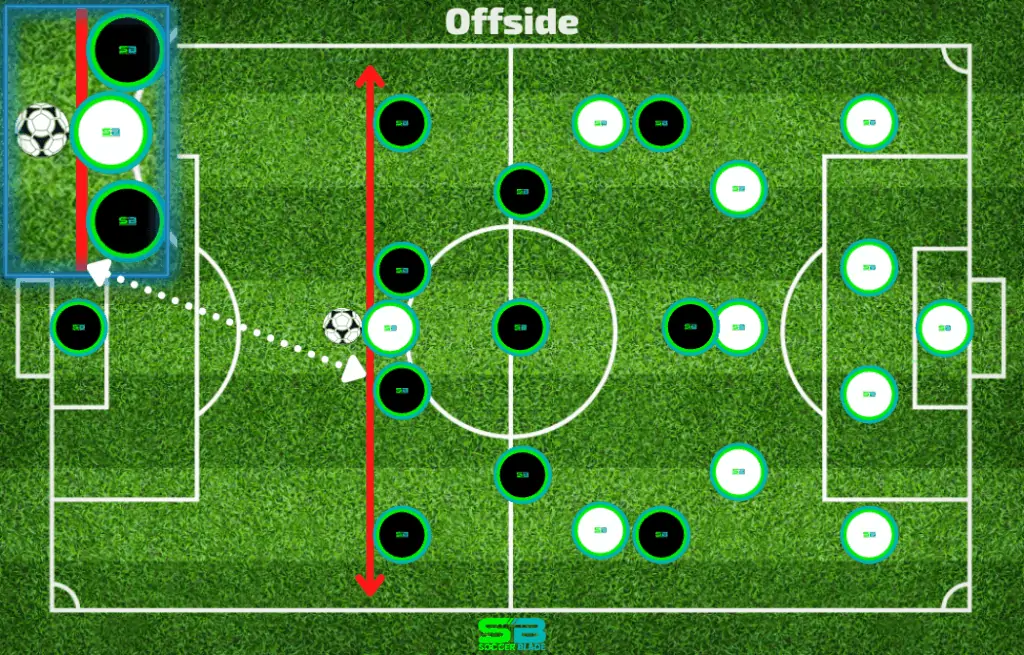
- What is Offside in Soccer?
- Offside In Soccer FAQ
- Why Does Soccer Have Offsides?
- New Offside Soccer Rule 2022
- The Offside Rule Today
- When you are not classed
- Offside Sanctions
- Becoming “involved in active play” rules:
- In-game Examples of Offside
- Offside Based Tactics
- What is the Offside Trap
- History of the Offside Rule
- Evolution of Soccer Rules
- Soccer Without Offsides
- What If There Were No Offsides?
- Should They Get Rid Of Offsides In Soccer?
- Is Offside Necessary?
- How Can I Play Soccer Without Offsides?
- What Sport Does Not Have Offside?
What is Offside in Soccer?
Offside is a rule in soccer that gives the opponent a free kick when the attacking players are past the last defender in the attacking half when the ball is played to them. It becomes a foul when a player touches the ball or interferes with play.
The offsider rule regulates the game to be a balance between short and long passes. This is so that the game is played in a contained area that promotes a variety of play.
Without the offside rule, soccer would descend into a game where the ball is hit from one end of the field to the other. This is with all players competing to score in a sea of chaos. It would be an unrecognizable game.
Thankfully, instead of this, we have ‘the beautiful game’: the most popular sport in the world, full of excitement, skill, athleticism, and tactical guile.
That being said, many people don’t fully understand the rule.
It’s not an offense to simply be in an offside position. If involved in active play from a touch by a teammate. The player in an offside position will be subsequently ruled offside and an indirect free-kick will be ruled against them.
Offside In Soccer FAQ
Here’s a quick overview of the offside rule in soccer and the most common questions people have;
Why Does Soccer Have Offsides?
The offside rule was created to prevent players from standing around the opponent’s goal, looking for easy opportunities to score. The law stops teams from using hit and hope, long-ball tactics at every opportunity.
The game might look a bit more like tennis if teams just kick from one end to the other.
While there is a valid time and place for direct strategies, consistently playing the game in this manner reduces the skill level significantly.
If offsides didn’t exist, you’d be watching tall, brutish athletes competing for headers for the majority of the game instead of talented, skillful, tactical, and well-organized teams lining up against each other.
The offside rule forces teams to play a more attractive brand of soccer and ensures skill and tactics are at the forefront of success.
New Offside Soccer Rule 2022
You can now be offside in soccer with the upper part of your arm – the top part of your arm from your armpit. It’s the same part of your arm that is not classed as handball. So you can effectively score with this part of your arm.
See the image below, what is part of the arm is not handball – this part of your body can now be offside;
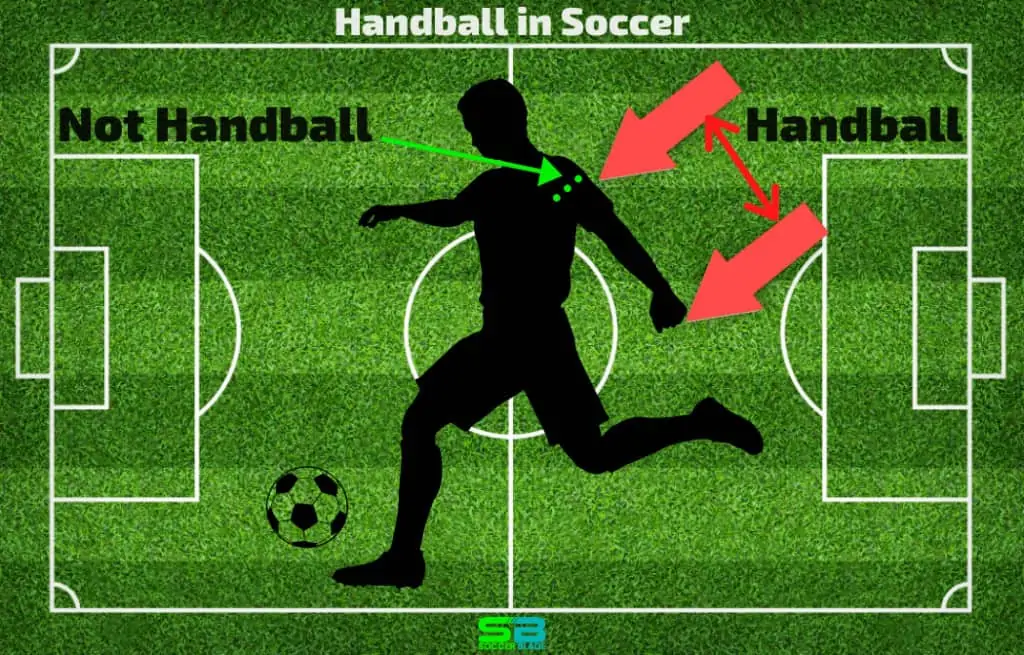
- An example of this rule in soccer was seen at a game between Chelsea FC and Liverpool FC. Belgium striker, Lukaku was in line with the defense, but he was leaning past the last defender when the ball was played.
Here’s a photo from Twitter about the incident;
Liverpool fans will say im hating but that offside call on Lukaku is bad for football! We saw what happened with the BS Middlesborough handball v United. Are referees advocating players using their arms in the buildup to goals? pic.twitter.com/OeCKZ4xP1u
— 20Times (@thereddevilway) February 28, 2022
Here is a video clip of the offside in action. Note, the shock of it being called for offside!
The Offside Rule Today
It’s common for the official offside rule to change. As soccer and technology evolve, the governing bodies are constantly trying to improve the game by tweaking rules.
Because international tournaments and most major domestic leagues now use video assistant referees (VAR), offsides have become extremely precise in recent seasons.
The English Premier League had significant teething problems with VAR and offsides. Soccer is an extremely free-flowing sport so most rules have elements of ambiguity to them, including offside. This allows referees to manage the game at their own discretion.
As offside is a relatively clear rule, vagueness and ambiguity had to be removed from the wording entirely to comply with video technology.
While soccer is still adapting to VAR, it’s being applied much more effectively for offsides after several years in the game.
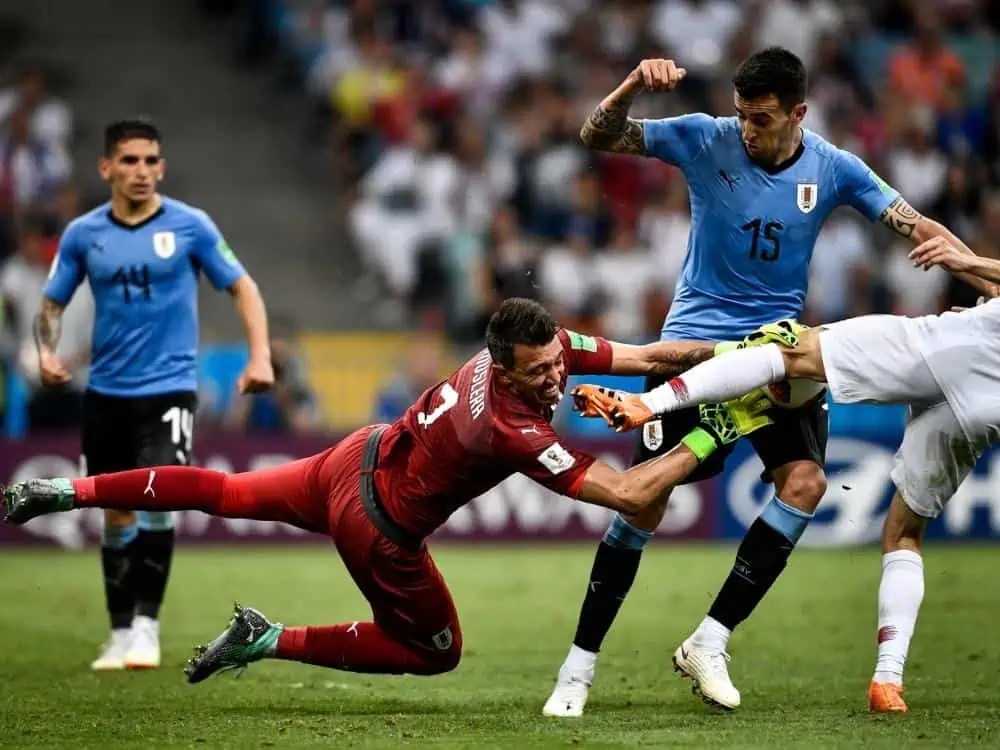
According to IFAB
Although there have been several minor changes since the offside rule as we know it today was introduced in 1990. The International Football Association Board (IFAB) is responsible for governing the laws of association soccer. Let’s take a look at the latest interpretation of offside according to IFAB.
A player is regarded as being in an offside position in the following circumstances:
- Their head, torso, or feet are in the opponent’s half (not including on the halfway line) and are closer to the opponent’s goal line than the second-last opponent (usually the last outfield player).
The Official Offside Soccer Rule
Here is the official soccer rule from the worldwide soccer officials IFAB;
“A player is in an offside position if:
• any part of the head, body or feet is in the opponents’ half (excluding the halfway line) and
• any part of the head, body or feet is nearer to the opponents’ goal line than both the ball and the second-last opponent.
The hands and arms of all players, including the goalkeepers, are not considered.
A player is not in an offside position if level with the:
• the second-last opponent or last two opponents”.
IFAB
Once the ball is kicked and the player in the above position is deemed to be interfering with play, the assistant referee flags for offside, and a free kick is awarded to the defending team.
A player doesn’t actually have to touch the ball to be flagged as offside. Interfering with the ball can mean inhibiting the movement of an opposing player, moving toward the ball, and challenging or tackling an opponent.
The arms and hands are not acknowledged in the offside rule as players are prohibited from using them. For clarification, the boundary between the body and arm starts at the bottom of the player’s armpit.
It’s important to note that a player is not regarded as being in an offside position if they are level with the second to last opponent.
When you are not classed
There are some exceptions to the offside rule. A player is not offside when receiving the ball directly from a goal kick, throw-in, or corner kick. This allows attacking players to gain a significant advantage with intelligent movement.
Goal Kicks
To ensure offsides ran smoothly in the original ruleset from the 1800s, offsides from goal kicks didn’t exist. Otherwise, all attacking players would have been flagged offside for every goal kick.
Although the offside rule changed several times from that point, the goal kick exception remained.
Throw-Ins
In the original rules, players could not be offside from a throw-in but because throw-ins had to be taken at right angles to the sidelines, it was difficult to get an attacking advantage.
When the rule changed to allow throw-ins to go in any direction, offsides were enabled. However, this slowed the game down significantly and encouraged teams to kick the ball out for throw-ins to waste time and stop the game.
In 1920, the law was readjusted again, meaning players couldn’t be offside from throw-ins.
This change was widely commended as it contributed to a more open and exciting game.
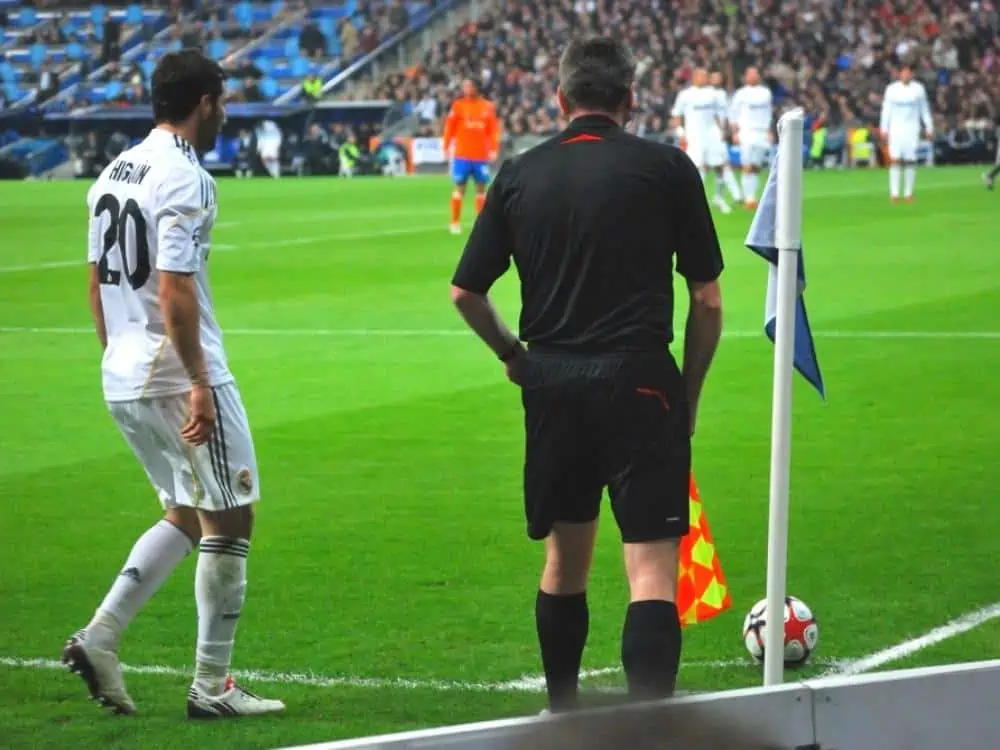
Corner Kicks
In the early days, corner kicks were taken from the actual corner of the field, where the flag is now planted. This made it impossible for any player to be offside from a corner as the ball was placed along the goal line.
Later, corner kick takers were allowed to move the ball approximately 1 foot from the corner, meaning their teammates could theoretically be offside.
However, corner kicks were officially listed as exceptions to the offside rule to prevent frequent controversy during games.
Offside Sanctions
If offside is called, an indirect free-kick is awarded against the team who committed the offense.
Players do not receive yellow or red cards for being offside. However, if you commit a cautionable or sending-off offense while offside, you can still be awarded a card.
Interestingly, according to IFAB Law, persistent breaking of the rules is a cautionable offense that is punishable by a yellow card.
“Cautionable Offences: Persistent offences (no specific number or pattern of offences constitutes ‘persistent’)”
IFAB Law 12.3 (disciplinary action)
So, in theory, if a player was intentionally lingering offside over and over again, the referee would be entitled to give them a card.
This scenario is highly unlikely, however, as it would put the player’s team at a significant disadvantage.
Becoming “involved in active play” rules:
- Interferes with play by touching a ball that’s passed or touched by a teammate.
- Prevents an opponent by obstructing their vision, by challenging them for the ball, or by making an obvious action to impact their ability to get the ball.
- Gains an advantage or interferes with an opponent when the ball is rebounded from the post, cross-bar, *opponent, or game official.
It’s important to note that if an opponent intentionally plays the ball and it’s intercepted by a player in an offside position. This is not regarded as gaining an advantage and so they will not be penalized for offside.
There are several pages of more specific circumstances and situations where offsides can occur in the IFAB rulebook.
However, these are the ‘small print’ and are not important to discuss in general terms.
There are exceptions to this offside rule.
A player cannot be ruled offside if;
They receive the ball directly from a throw-in, a corner-kick, or a goal-kick.
In most cases, the linesman or assistant referee, who operates on the sidelines of the field, is in charge of monitoring and flagging offsides.
What’s the maximum penalty for being offside?
The maximum penalty for offside is an indirect freekick. It’s not a bookable offense to be caught offside.
Can a goalkeeper be offside?
Yes. A goalkeeper can be offside in the same way that an outfield player can be.
In-game Examples of Offside
Below are some screengrabs of in-game offsides. This should give you a clearer indication of what offside is and when players are in offside positions.
Clear Offside Example
In the above example, we can clearly see that blue number 18 (Morgan Schneiderlin of Everton) is in an offside position.
If the teammate plays the ball to him in this situation, he will be ruled offside.
The second to last red defender is their number 21 (Diego Rico of Bournemouth), who is clearly several feet in front of the attacker. This is a straightforward offside call.
Clear Onside Example
In the above example, we can clearly see that the furthest attacking green player (Eden Hazard of Real Madrid) is in front of the defender when the ball is being passed.
This means that the attacking player is in an onside position and play will go on as normal.
In the above example, the passing player is kicking the ball to his left (to Karim Benzema of Real Madrid).
The receiver is clearly in front of the second and third to last defender, meaning he is onside. Both of these examples are straightforward, onside calls.
Close Offside Example
In the above example, we can see an instance where it’s difficult to tell from the naked eye whether a player is offside or onside.
- First, please note that the 2 furthest forward players in white are in offside positions.
Now, please turn your attention to the player in white at the top of the image. From our angle, one could debate whether or not the player is in an offside position.
His feet appear to be in front of at least one defender. However, a player can be deemed offside if any part of the body that the player can score with is in an offside position.
In this instance, the attacker’s left shoulder is in a potentially offside position. It’s tight calls like this when VAR and advanced offside technology come in useful.
When we look at examples such as this one, there is no wonder that offside debates are had every week of the soccer season.
Is a player automatically offside if they’re behind the goalkeeper?
The goalkeeper is regarded as the ‘last defender’. Therefore, if a player passes a ball forward to a teammate when they’re behind the goalkeeper, they’re offside.
Offside Based Tactics
Offsides can be incorporated into certain tactical and formational plans made by coaches.
They may use a high-defensive line or a low-block defensive structure, depending on the playing style of their opponent.
Offensively, certain players might occupy specific areas of the field that coaches see as vulnerable in offside terms.
A player who lacks pace is consistently slow at joining their defensive line during transitions.
This could lead to opportunities for a fast striker to gain a few yards on their defender if possession is turned over.
Offsides are part and parcel of the game, in all areas. However, there are instances where offside is used directly as a tactic.
A good example of this is the offside trap.
What is the Offside Trap
The offside trap is a defensive tactic where the defense attempts to catch the attacking team in an offside position by moving forward before the ball is played.
The offside trap can be executed in several ways but the two main instances that we see it being used are when teams are defending free kicks or if a player steps up during a game to render their opponent offside.
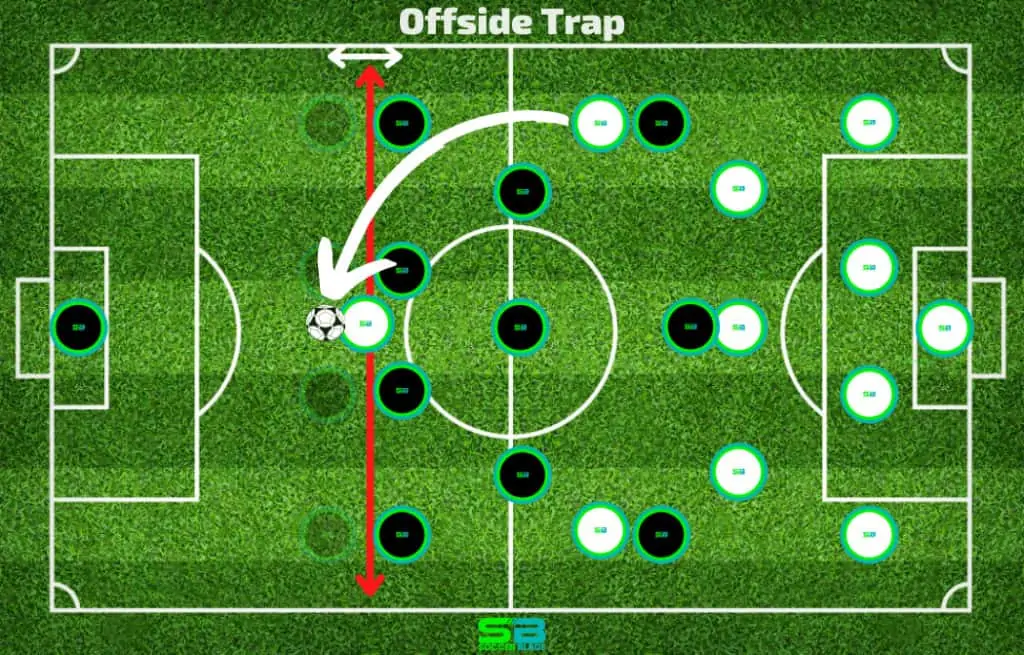
Offside Trap From a free-kick
It’s important to note that a player will not be ruled offside if they receive the ball directly from a throw-in, goal kick, corner-kick, or inside their own half.
- Executing the offside trap: players line up in their usual defensive line. Just before the opposition plays the ball behind a team’s defense, the defensive line runs ahead of the opposing attacker(s) to put them in an offside position.
As the name suggests, this is a ‘trap’, so it generally only works if the opponents don’t know that it’s coming.
It’s important for the defensive team to have this well-drilled and to communicate with each other on the field so that they execute the play as a unit.
When it comes off, the offside trap from a free kick works an absolute treat. However, it’s a risky maneuver, particularly in the VAR era, where the defense cannot deceive the game officials.
If the offside trap is not executed well, the offensive team will most likely have a clear goalscoring opportunity.
Offside trap In-game Offside
This is a lot trickier as it involves quick thinking and is not a pre-meditated and rehearsed set-play.
An in-game offside trap is where the last defender anticipates a pass to the opposition striker. The defender sprints ahead of their opponent, before their teammate passes the ball to them, leaving the attacker in an offside position.
This works more often than you may think, as generally the defender and the attacker are moving in opposite directions, meaning the distance between them can be created very quickly.
Defenders must be aware of their position as well as the position of their teammates.
If a defender attempts to catch their opponent offside, unaware that their teammate is behind them keeping the striker onside, the striker gains a huge advantage.
We often see defenders attempting to do this in a desperate panic when they’re caught in a poor position.
History of the Offside Rule
Offsides have not always existed in the same fashion that they do today. It’s a rule that has undergone much change over the years.
Let’s take a look at how it all started. Before the unified rules of soccer were agreed upon, the sport existed in many different forms.
Rulesets differed so severely that in some instances the game couldn’t even be compared to today.
- The Cambridge Unified Rules of soccer were established in 1863. In the original ruleset, there had to be three defenders between the attacker and the goal, or else the attacker was regarded as being in an offside position.
This later changed to two defenders (in the 1900s). This simple change led to a 35% increase in scoring that year.
Offside Rule Change
The offside rule has changed from the second-last defender, an advantage to the attacker, and VAR. With a change of emphasis on creating a more attacking playing style, a significant change to the offside rule was made in 1990.
A player was now ruled to be in an onside position if they were level with the second to last opponent. This rule change would lead to a more free-flowing game. Since 1990, changes to the offside rule have been made from time to time, with a general focus on giving the attackers the advantage.
The most significant rule change made to influence the game since then has been the introduction of technology into the sport of soccer, in particular, VAR (video-assisted referee).

Evolution of Soccer Rules
The sport of soccer is constantly evolving. There are adjustments to rules and regulations every season. We have seen considerable changes in the game of late, especially with the introduction of VAR and other in-game technology.
Goal-line technology detects all shots that cross the goal line. This has removed controversy surrounding close calls in the goalmouth. VAR was introduced to have a similar effect on offside calls.
However, as the 2019/20 EPL season has shown so far, offsides are still causing huge drama in the sport. We may yet see further changes to the offside rule and how it’s officiated in the coming months. Why offsides in soccer?
- If you want to read up on these finer details, check out the IFAB rulebook and skip to page 98. In the most simple terms possible, offside is where a player is in their opponent’s half and they’re closer to the goal-line than the ball and the second-last opponent when the ball is played.
You decide, would the game be chaotic or entertaining without offsides? – it sure would be interesting! Let’s take a look at soccer without offsides …
Soccer Without Offsides
Soccer without offsides would create a different type of game. There would be a big increase in the number of long balls and fewer short passes.
Since the first official rules of “association football” (soccer) were introduced in 1863, offside has been part of the game in some capacity.
The first offside rules were a far cry from those adhered to today because of how the game was originally played. When the first set of rules was created, players had to be behind the ball when their teammate made a pass.
Later, “association football” branched into different sports, where rugby retained this type of offside rule.
As soccer developed, so too did the offside rule. Different variations existed until 1925 when the first version of modern offsides came about. At the time it was referred to as the “two-player offside rule”.
According to the two-player rule, when the ball was kicked, any player on the kicker’s team who was ahead of the ball was regarded as offside, unless there were two opposing players between them and the goal line.
Before this, there was a “three-player offside rule”, which was essentially the same but with three players between the ball receiver and the goal line instead of two.
- The introduction of the two-player offside rule led to a dramatic increase in goals scored, climbing from 4,700 to 6,373 in a single season in the English Football League. However, this would eventually cause teams to adopt more defensive strategies.
So, while offsides have always existed in soccer, the rules have developed significantly over the years.

What If There Were No Offsides?
Such a drastic rule change would enable teams to be more expansive, stretching the play over the full length of the field. This would likely increase the number of goals per game significantly, which could make matches even more exciting.
Although higher-scoring games are fun and entertaining, no offsides could remove the tactical art from the game completely. Teams would look for the most direct route to the goal, resulting in long ball strategies.
The game could easily descend into chaos with multiple players competing for crosses, long passes, and even goal kicks at every opportunity.
Should They Get Rid Of Offsides In Soccer?
Offsides force teams to play more skillfully, with tactics and organization. True fans who enjoy the art of possession-based soccer, accurate passing, expert dribbling, and tactical play, are unlikely to petition for getting rid of offsides.
- With no offsides, the Messi’s of this world may never have existed.
Soccer without offsides would essentially mean trading tactics for size and speed for strength. Players like Kylian Mbappe and Gareth Bale have always used blistering speed to break defensive lines, taking advantage of offsides. Quick feet and speed would be less relevant without offsides.
However, for those who don’t fully understand the game, strategy, and skillset, perhaps getting rid of offsides would make soccer more appealing.
More goals, a higher pace, and a simpler way of playing may make soccer more accessible to new fans.
Is Offside Necessary?
Although official games at amateur and professional levels generally incorporate standard offside rules, it’s possible to play soccer without offsides.
Outside of the professional sphere, games are usually officiated by one referee. It’s logistically and financially very difficult to have two linesmen or lineswomen and a referee available for every game.
To combat this, some local leagues or smaller soccer organizations play without offsides. The games are usually kept under control with a smaller field or some different rules.
Let’s take a look at how you can play soccer without offsides.

How Can I Play Soccer Without Offsides?
Offsides can be difficult to officiate with a single referee and are impossible to monitor without one. Therefore, some recreational leagues and underage soccer games are played without offsides.
In fact, most games played on smaller soccer fields or with fewer players on each team will forego offside rules entirely.
On a small field, such as an indoor court or astroturf field, offsides have less of an impact and can be mitigated more easily.
For such games, it’s common to incorporate different rules instead of offsides. If you’re looking for ways to play without the offside rule, think about incorporating some fun alternatives:
Outside The Box
Instead of offside, consider playing a game with an “outside the box” rule for scoring. This means that you’re not allowed to score unless you shoot from outside the box.
The “outside the box” rule discourages players from hovering next to the goal, looking for easy chances.
Even if some players are consistently playing in advanced positions, having to shoot from outside the box makes it much harder to score.
Pass Before You Score
Another rule that can be used instead of offside is “pass before you score”. Under this rule, teams must string together consecutive passes before they are allowed to score.
Depending on how many players you have, as well as their skill level, the number of required passes should vary.
While skilled teams may be capable of putting together 15 or more passes, this isn’t a realistic target for most casual players. Consider starting at 5 consecutive passes and go from there.
This might not seem like a lot on paper, but completing 5 passes on every possession becomes very challenging, especially when teams implement a high-intensity press.

One Defender Back
The “one defender back” rule is most commonly played in 5-a-side soccer or astroturf games.
With this rule, each team must have at least one defender in their half of the field at all times, ensuring teams keep their structure and stopping play from being too open, loose, and disorganized.
Kicking Height Limit
Setting a height limit for kicking the ball stops teams from playing the long ball strategy, and encourages more skillful play.
Each time a player kicks the ball at a certain height, a free kick is awarded to the opposing team.
These types of rules are easier to follow, particularly among friends where there is no referee.
However, when it comes to 11 vs 11 on a full-size soccer field, offside once again becomes one of the most important rules.
If you’re interested in refereeing your local leagues, get all the equipment you need with this referee starter kit.
What Sport Does Not Have Offside?
Offside is a common rule in many sports. Although, it’s generally applied in a unique way, depending on the sport. The term offside comes from a military term describing soldiers who are stuck behind enemy lines.
Whatever the sport, the offside rule typically revolves around illegal positions and movements.
Popular sports that don’t have offsides include:
- Basketball
- Volleyball
- Tennis
- Squash
- Australian rule football
Variations of soccer that don’t use the offside rule include indoor soccer, futsal, beach soccer, and 5-a-side soccer.
Share the post "Offsides in Soccer (Guide With Examples)"
Joel is a seasoned soccer journalist and analyst with many years of experience in the field. Joel specializes in game analysis, player profiles, transfer news, and has a keen eye for the tactical nuances of the game. He played at various levels in the game and coached teams - he is happy to share his insight with you.



